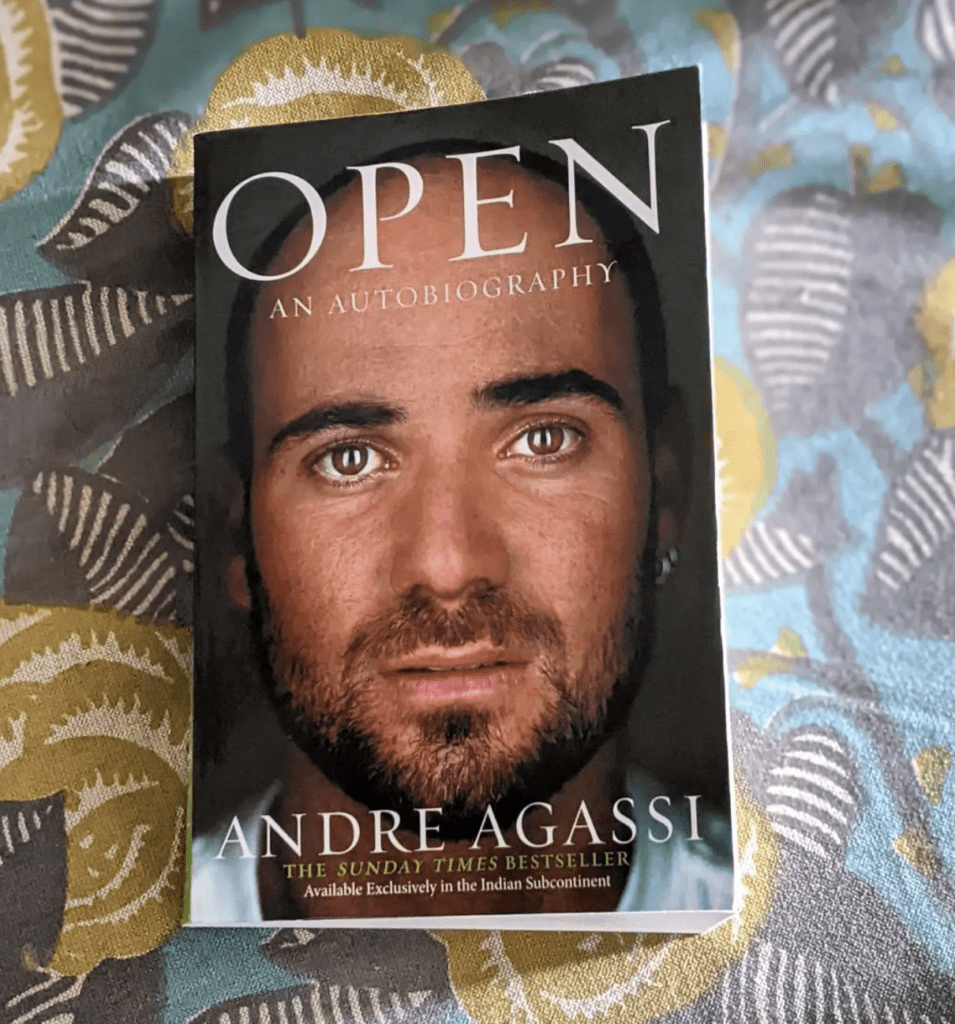Andre Agassi
I picked up the book after reading an interesting anecdote from it on how Agassi cracked the Boom Boom Becker serve, and then only sparingly used the knowledge so Becker wouldn’t know he knew the tell! I haven’t read autobiographies before and didn’t know what to expect, but what I did get from it was a classic five-setter between Agassi and Sampras. And as it goes, if it reaches the fifth set, Agassi invariably wins.
In simplistic terms, it might be the hero’s journey archetype, but from the very first page, Agassi gets you invested in his life. He invites you to see the person beyond the personalities with a vulnerability and warmth that I really didn’t expect to find. Personalities because his appearance and public persona have changed with age. His initials are after all AKA, we are reminded late in the book. Both Andre and Kirk are names of his father’s bosses!
I was a half-fan of the version late in his career. Only half because Steffi married him*, and I couldn’t live with that. He also provides a behind-the-scenes view of his tennis – a life he can only describe as a ‘whirl’, and a blow by blow account of various matches – his game, his physical and emotional battles, the sheer pain in the body and the mind, none of which the viewing audience knew about. And that’s probably why you start rooting for him as we go through the journey.
His father, an Armenian born in Iran, and an Olympian boxer, got him into tennis really early, and those years probably explains his love-hate relationship with the game. No one asked him if he wanted it. But his father did want it, and taught his son to take the opponent’s best punch and still be standing. The philosophy that made the best return in the game, and psychologically defeated opponents. His dad also proclaimed early to Connors, while stringing his rackets in Vegas, that he (Agassi) would be number one in the world. Connors seems to have been quite an influence – the guy Agassi didn’t want to become. Not carrying his own bag to court, not remembering Agassi when they played officially, and not even applauding after Agassi’s last match.
The journey goes through Nick Bollettieri’s Tennis Academy, which also marked the beginning of half a life long rebellion – beginning with mohawks, ear-rings, breaking rules and even a vow of silence. Then follows the first offer from Nike, reaching the first final after turning pro and losing to Ramesh Krishnan, the mullet and the famous Nike denim shorts that apparently McEnroe rejected, hairpieces and bandannas, meeting Gil who became a father-figure, the vilification courtesy Canon’s “Image is everything” campaign, the first Grand Slam win at Wimbledon beating Goran Ivanišević, getting Brad Gilbert as coach, the many injuries, testing positive with meth and getting away with it thanks to an untrue apology, the Grand Slam wins, the revamped version with Darren Cahill as the coach, his retirement match against Becker (not Boris, Benjamin), and in general being “The Punisher”.
In parallel run the personal relationships – long-time girlfriend Wendi, the friendship with Barbra Streisand, marriage with Brooke Shields (trivia: in 1994 Agassi became the first unseeded player to win the US Open after Frank Shields in 1966 – Brooke’s grandfather), and the romance with Stefanie Graf. There are interesting stories – how he had a crush on Steffi and how crushed he was when the Wimbledon dance (for champions) was canceled, and how Brook Shields had a photo of Graf pinned for motivation because she thought Graf had the best legs.
For me, the book was also a lot of nostalgia – of the time I used to follow the sport. It’s fascinating to see the eras pass – Agassi as the young turk to Connors and McEnroe, the younger foe to Lendl, Edberg and Becker, the contemporary to Courier, Chang, Rafter and relatively lesser known names like Todd Martin, Wayne Ferreira, Sergi Bruguera, Thomas Muster, the classic rivalry with Sampras, and towards the end, playing and recognising the future greatness of Federer (“most people have weaknesses, Federer has none”) and Nadal (“I’ve never seen anyone move like that on a tennis court”). It is also the fascinating story of a man who was “neither punk nor paragon”. All he wanted was his own pace and space to find himself. That’s something I could relate to. Great read!
* Now that I know what the person is about, I can finally live with the fact that Steffi is married, and even be a bit happy for him.

